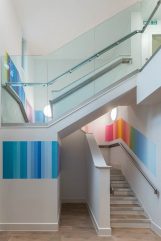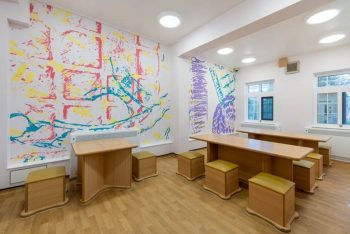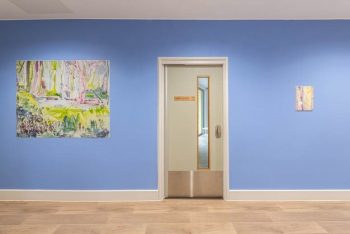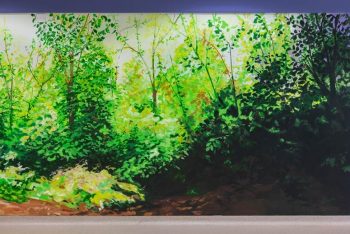Making non-clinical art for the clinical setting by Tim A Shaw

*Richard Woods – Entrance to education building – Bluebird House – Image courtesy of Hospital Rooms – Photography Damian Griffiths
The words ‘art for hospitals’ conjures up all sorts of mental imagery – butterfly stickers pasted onto walls, beach scene decals, pixelated soft-focus landscapes, shallow depth of field photographs of flowers, a jetty leading off into the distance. All displayed in heavy wood frames secured by mirror plates or mounted behind wipeable perspex. Pictures are often hung very high, or confusingly low, and the subject matter is thought to be ‘safe’, ‘inoffensive’ and ‘calming’.

Tim A Shaw – Entrance – Jasmine Lodge – Image courtesy of Hospital Rooms – Photography Damian Griffiths
When it comes to art, hospitals can be averse to change, colour and risk. This can be even starker when we think about inpatient mental health hospitals. In inpatient mental health units, an artwork can become something with the potential l to be harmful. To be compliant, any artwork that is installed has to be ligature-free, sterile and scrubbable, and close to impossible to be able to be removed or destroyed. This is completely understandable, as in many inpatient units there will be people who may be at serious risk of self-harm, and a glazed work of art, a screw sticking out of the wall, or a bacteria-harbouring fabric work has the potential to be dangerous.
However, we need to question whether art that needs to be sterile needs to be sterile art.
There is a lot of received wisdom when it comes to art for the inpatient environment. Chinese whispers through the health system stating that white or beige is best for environments that are for people who are mentally unwell, or that there is evidence that landscape pictures are better than abstract art, is unhelpful. These mistruths hinder innovation, progress, and opportunities for artists to experiment and try new things in hospital environments. It’s important to acknowledge that everyone has their own history with colour. White can be a calming colour to some people, but it can be as malignant a colour as any for many people, especially if it represents seclusion, restraint, and segregation, and may not be an innocuous and safe colour at all.
In a similar way, there is a lot of room for landscape imagery in mental health hospitals – art inspired by nature can bring the outside in, open up space and refer to a less bleak world outside. However, just because people generally like landscapes and the outdoors, it doesn’t mean every artwork made for hospitals has to be a landscape.
I am one of the co-founders of an arts and mental health charity called Hospital Rooms, and we work with artists and mental health patients to transform some of the bleakest and sterile inpatient units with extraordinary artworks. Art does not have to exist to be liked by all, but often the most powerful and positive works we have commissioned have been those that are open to interpretation, stimulate conversation and ideas, intellectually challenge and often acknowledge struggle in a way that offers some hope.

Harold Offeh_Croydon PICU_Dining Room_Photo by Damien Griffiths_Courtesy of Hospital Rooms
There is a responsibility that comes with making artwork for a mental health unit where people don’t have a choice to come and go as they please. But this doesn’t mean that nothing creative should happen in the inpatient environment. By bringing artists, patients, and staff together, there can be a collaborative energy of creative problem-solving. There can then be the possibility to figure out how art can both improve an otherwise clinical environment while making something that is non-patronising, and that ins=ls feelings of self-worth.

Tamsin Relly – Entrance – Jasmine Lodge – Image courtesy of Hospital Rooms – Photography Damian Griffiths

Hannah Brown Atrium Hellingly Centre Courtesy Hospital Rooms Photography Damian Griffiths

